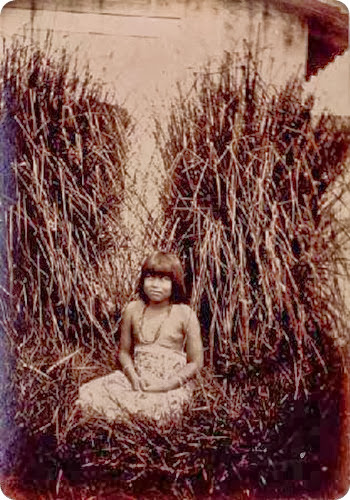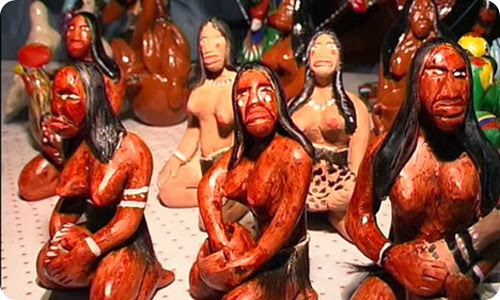Indigenous Peoples: the Toba.
The Toba ethnicity in their language called himself ntokóit, then began using the autoetnónimo q'om or Qom (man) and more infrequently by the use of their own language: qom'lek or qom'lik. As usually happens with the spellings of Indian names are many variations in the writing of these words.
The name is a nickname tova Guarani and means "front" because the Qom decalvación often engaged in the front of the scalp, for the same reason the Spanish called them "Frentones" (name also given to similar grounds abipones ). In Paraguay, the name also used emok, Enlhet term meaning neighbor or citizen.

In 2007 the major groupings of these people are in the east of the department of Tarija in Bolivia, in the east of the province of Formosa, center and east of the province of Chaco and northern Santa Fe province in Argentina and the Chaco Boreal of Paraguay. In Argentina are about 20,600 (19,800 speakers of the language), 700 146 in Bolivia and Paraguay. In the west of the province of Formosa have pilagás mixogenizado with being called tufa-pilagás.
There is intense internal migration to the Greater Rosario (Barrio Toba meeting there of Rosario) and to the northeast of the province of Santiago del Estero. Another settlement Barrio Toba (La Plata) is in the Partido de La Plata in Buenos Aires province.
As typical pámpidos are characterized by high and dominate sizes including dolichocephalic individuals.
They are considered one of the most important ethnic group called guaycurú (or guaykurú) insulting tone voice that gave the Guarani to its main opponents in the Gran Chaco.
Their language is called qomlaqtaq and from the linguistic point of view it is usually placed within the guaycurúes language group, or the macropanoanas. It is part of the linguistic family mataco-guaycurú.
Until the nineteenth century were a people predominantly semi-nomadic hunter-gatherer marching towards their food resources and existed between them a strong sexual division of labor: men from an early age engaged in hunting and fishing and women to the collection and incipient agriculture horticulture largely influenced by contributions ándidos and amazónidos. Thus, in small plots cultivated nachitek (squash), oltañi (corn), avagha (beans), sweet potatoes, cassava, etc.. However, such cultures were only complementary to your diet and failed to get excess to the accumulation of agricultural foods. There is an ecological explanation for this apparent delay: climate and soil science did not allow its territory sufficient yields for their agricultural products, while in the wild Chaco territory they found a source of food, especially high-quality protein . The Qom mainly hunted tapirs, peccaries, deer, guanacos and lots of birds. Complementing used to collect honey and lots of fruits, berries and wild roots.
The Spanish presence meant a great revolution for them: first they found a powerful new enemy on the other the Spanish inadvertently made a great contribution to their culture: in the seventeenth century the Toba began using the horse and Become Sound Suddenly a powerful equestrian complex in the center and south of the Gran Chaco (Chaco Gualamba). They became skilled riders although its territory was largely covered with forests and jungles (to ride a horse under the trees used to wear on their heads a hide cleverly attached to your body, as to resist the thorns of the trees and the attacks by pumas and jaguars that suddenly they could jump from the branches).
With the adoption of riding could extend their raids, becoming the dominant ethnic group of the Central Chaco (full moons advantage with their horses to cross the river Paraguay and raiding the villages near the left bank of the river in the nation currently namesake) . Horse domain also allowed them to advance to the Chaco Austral and even make lightning raids over the corresponding area northwest of the Pampas. From their horses, armed with bow and arrow hunting native animals but not only cattle of European origin.
The tuffs proved to be one of the ethnic groups that opposed the attempt increased resistance of acculturation and usurpation of the white man in the Chaco region, arriving in 1858 to threaten the city of Santa Fe, but since 1880, could not cope with the Argentine Army campaigns they Impenetrable Chaco cornered.
In 1919 the last war of resistance was shot in Napalpí Qom, in the province of Chaco, where 200 of them were massacred in the event known as Slaughter of Napalpí. Many were forced to work on cotton plantations or as woodcutters in the mills.
Culture:
The culture of the Toba was functional to their customs and traditions, living in rooms covered with straw logs, dwellings that used to measure about two meters in diameter. They made pottery, basketry and textiles primarily utilitarian purposes.
During the warm months hardly used except for simple clothing loincloth. In periods used fresh clothes complex and on the occasion of their ritual celebrations were adorned. Thus had a dress made of fibers called poto caraguata, leather and after the Spanish invasion, with cotton.
Also during cold periods came to bundle with ponchos. Adult males adorned their heads with opaga kind of headdress made with feathers and ropes caraguatá. Women and men were adorned with bracelets mean onguaghachik is originally concocted using teeth and claws of animals, seeds, feathers, shells or cochlea or snail shells and (apparently to get some of these items practiced barter trade with other ethnic groups) In making these bracelets were similar to the colaq or necklaces. As for nallaghachik these were eminently festive ornaments, very colorful, made with feathers, flowers and leaves.
Religion: For their belief system has described them animist and shamanistic, had a cult of nature beings and the belief in a deity maximum. Since the twentieth century still remain resistant oral transmission, this religious system but many have adopted Christianity in its way, including the so-called Pentecostal because their shamans in many cases became pastors. In any case even today much of the population attends Qom their shamans or pio'oxonak who are therapists or healers.
efore acceptance of Christianity was prevalent among them infanticide of newborn habit was due to the scarcity of food resources used to suffer. By contrast, children who survived were treated with special dedication and affection.

source: Argentina Photo Gallery


